- College Essay
- Argumentative Essay
- Expository Essay
- Narrative Essay
- Descriptive Essay
- Scholarship Essay
- Admission Essay
- Reflective Essay
- Nursing Essay
- Economics Essay
Assignments
- Term Papers
- Research Papers
- Case Studies
- Dissertation
- Presentation
- Editing Help
- Cheap Essay Writing
- How to Order
Speech Writing
Introduction Speech

Introduction Speech- Tips & Examples
10 min read

People also read
The 10 Key Steps for Perfect Speech Writing
Understanding Speech Format - Simple Steps for Outlining
How to Start A Speech - 13 Interesting Ideas & Examples
20+ Outstanding Speech Examples for Your Help
Common Types of Speeches that Every Speechwriter Should Know
Good Impromptu Speech Topics for Students
Entertaining Speech Topics for Your Next Debate
Understanding Special Occasion Speech: Types, Steps, Examples and Tips
How to Write A Good Acceptance Speech?
Writing A Presentation Speech In English: Tips And Examples
Commemorative Speech - Writing Guide, Outline & Examples
Farewell Speech | Writing Tips & Examples
How to Write an Extemporaneous Speech? A Step-by-Step Guide
A Graduation Speech Writing Guide with Examples
Introduction speeches are all around us. Whenever we meet a new group of people in formal settings, we have to introduce ourselves. That’s what an introduction speech is all about.
When you're facing a formal audience, your ability to deliver a compelling introductory speech can make a lot of difference. With the correct approach, you can build credibility and connections.
In this blog, we'll take you through the steps to craft an impactful introduction speech. You’ll also get examples and valuable tips to ensure you leave a lasting impression.
So, let's dive in!
- 1. What is an Introduction Speech?
- 2. How to Write an Introduction Speech?
- 3. Introduction Speech Outline
- 4. Introduction Speech Example
- 5. Introduction Speech Ideas
- 6. 7 Tips for Delivering the Best Introduction Speech
What is an Introduction Speech?
An introduction speech, or introductory address, is a brief presentation at the beginning of an event or public speaking engagement. Its primary purpose is to establish a connection with the audience and to introduce yourself or the main speaker.
This type of speech is commonly used in a variety of situations, including:
- Public Speaking: When you step onto a stage to address a large crowd, you start with an introduction to establish your presence and engage the audience.
- Networking Events: When meeting new people in professional or social settings, an effective introduction speech can help you make a memorable first impression.
- Formal Gatherings: From weddings to conferences, introductions set the tone for the event and create a warm and welcoming atmosphere.
In other words, an introduction speech is simply a way to introduce yourself to a crowd of people.
How to Write an Introduction Speech?
Before you can just go and deliver your speech, you need to prepare for it. Writing a speech helps you organize your ideas and prepare your speech effectively.
Here is how to introduce yourself in a speech.
- Know Your Audience
Understanding your audience is crucial. Consider their interests, backgrounds, and expectations to tailor your introduction accordingly.
For instance, the audience members could be your colleagues, new classmates, or various guests depending on the occasion. Understanding your audience will help you decide what they are expecting from you as a speaker.
- Opening the Speech with a Hook
The best speech introduction starts with a hook or opening line that grabs your audience's attention. This could be a surprising fact, a relevant quote, or a thought-provoking question about yourself or the occasion.
- Introduce Yourself
Introduce yourself to the audience. State your name, occupation, or other details relevant to the occasion. You should have mentioned the reason for your speech clearly. It will build your credibility and give the readers reasons to stay with you and read your speech.
- Keep It Concise
So how long is an introduction speech?
Introduction speeches should be brief and to the point. Aim for around 1-2 minutes in most cases. Avoid overloading the introduction with excessive details.
- Highlight Key Points
Mention the most important information that establishes the speaker's credibility or your own qualifications. Write down any relevant achievements, expertise, or credentials to include in your speech. Encourage the audience to connect with you using relatable anecdotes or common interests.
- Rehearse and Edit
Practice your introduction speech to ensure it flows smoothly and stays within the time frame. Edit out any unnecessary information, ensuring it's concise and impactful.
- Tailor for the Occasion
Adjust the tone and content of your introduction speech to match the formality and purpose of the event. What works for a business conference may not be suitable for a casual gathering.
Introduction Speech Outline
To assist you in creating a structured and effective introduction speech, here's a simple speech format that you can follow:
|
Here is an example outline for a self-introduction speech.
Outline for Self-Introduction Speech
Introduction Speech Example
So if you are wondering what to say in an introduction speech we have you covered! We have compiled introduction speech examples to help you understand how to put your ideas into practice for different scenarios.
Introduction Speech Writing Sample
Short Introduction Speech Sample
Self Introduction Speech for College Students
Introduction Speech about Yourself
Student Presentation Introduction Speech Script
Teacher Introduction Speech
New Employee Self Introduction Speech
Introduction Speech for Chief Guest
Moreover, here is a video example of a self-introduction speech. Watch it to understand how you should deliver your speech:
Want to read examples for other kinds of speeches? Find the best speeches at our blog about speech examples !
What Are Some Famous Introduction Speeches?
Here are the best introduction speeches for students to get inspired:
- Malala Yousafzai's Nobel Peace Prize Acceptance Speech (2014) : Malala's speech upon receiving the Nobel Peace Prize introduced her advocacy for girls' education and youth empowerment globally.
- Elon Musk's Presentation on SpaceX Interplanetary Transport System (2016) : Elon Musk introduced SpaceX's ambitious plans for interplanetary travel, outlining a vision for the future of space exploration.
- Michelle Obama's Democratic National Convention Speech (2008) : Michelle Obama's speech introduced her as a potential First Lady, sharing personal stories and values that resonated with the audience.
- J.K. Rowling's Harvard Commencement Speech (2008) : Rowling's speech introduced themes of failure, imagination, and resilience, drawing from her personal journey as an author and philanthropist.
Introduction Speech Ideas
So now that you’ve understood what an introduction speech is, you may want to write one of your own. So what should you talk about?
The following are some sample introduction speech topics and ideas that can provide an engaging start to a presentation, meeting, or social gathering.
- Personal Story: Share a brief personal story or experience that has shaped you.
- Professional Background: Highlight your career achievements and expertise.
- Hobby or Passion: Discuss a hobby or passion you're enthusiastic about.
- Volunteer Work: Talk about your involvement in volunteer work or community service.
- Travel Adventures: Share anecdotes from your travel adventures.
- Books or Literature: Provide an introduction related to a favorite book, author, or literary work.
- Achievements and Milestones: Highlight significant achievements and milestones in your life or career.
- Cultural Heritage: Explore your cultural heritage and its influence on your identity.
- Social or Environmental Cause: Discuss your dedication to a particular social or environmental cause.
- Future Aspirations: Share your future goals and aspirations.
You can deliver engaging speeches on all kinds of topics. Here is a list of entertaining speech topics to get inspiration.
7 Tips for Delivering the Best Introduction Speech
Now that you know how to write an effective introduction speech, let's focus on the delivery. The way you present your introduction is just as important as the content itself. Here are some valuable tips to ensure you deliver a better introduction speech:
Tip# 1: Maintain Eye Contact
Make eye contact with the audience to establish a connection. This shows confidence and engages your listeners.
Tip# 2: Use Appropriate Body Language
Your body language should convey confidence and warmth. Stand or sit up straight, use open gestures, and avoid fidgeting.
Tip# 3: Mind Your Pace
Speak at a moderate pace, avoiding rapid speech. A well-paced speech is easier to follow and more engaging.
Tip# 4: Avoid Filler Words
Minimize the use of filler words such as "um," "uh," and "like." They can be distracting and detract from your message.
Tip# 5: Be Enthusiastic
Convey enthusiasm about the topic or the speaker. Your energy can be contagious and inspire the audience's interest.
Tip# 6: Practice, Practice, Practice
Rehearse your speech multiple times. Practice in front of a mirror, record yourself or seek feedback from others.
Tip# 7: Be Mindful of Time
Stay within the allocated time for your introduction. Going too long can make your speech too boring for the audience.
Mistakes to Avoid in an Introduction Speech
When crafting and delivering an introduction speech, it's important to avoid common pitfalls that can reduce its impact. Here are some mistakes to watch out for:
- Rambling On: Avoid making the introduction too long. Keep it short and sweet to set the stage without stealing the spotlight.
- Lack of Preparation: Not preparing enough can lead to awkward pauses or losing your train of thought. Practice your speech to feel more confident.
- Using Jargon or Complex Language: Steer clear of technical jargon or complicated language that might confuse the audience. Keep it simple and clear.
- Being Too Generic: A bland introduction can set a dull tone. Make your speech specific to the event and the speaker to keep it engaging.
- Using Inappropriate Humor: Be careful with humor. Avoid jokes that could offend or alienate the audience.
- Overloading with Background Information: Providing too much background information can overwhelm the audience. Offer just enough to give context without bogging down the introduction.
To Conclude,
An introduction speech is more than just a formality. It's an opportunity to engage, inspire, and connect with your audience in a meaningful way.
With the help of this blog, you're well-equipped to shine in various contexts. So, step onto that stage, speak confidently, and captivate your audience from the very first word.
Moreover, you’re not alone in your journey to becoming a confident introducer. If you ever need assistance, you can place a pay to do my essay request and let the experts help you out.
MyPerfectWords.com offers a custom essay service with experienced professionals who can craft tailored introductions, ensuring your speech makes a lasting impact.
Don't hesitate; hire our professional speech writing service to deliver top-quality speeches at your deadline!
Frequently Asked Questions
How long should a speech introduction be.
A speech introduction should be concise, typically lasting about 1 to 2 minutes. It should set the stage, capture the audience's attention, and provide a clear direction for the rest of the speech.
What Is the Best Speech Introduction Greeting?
The best greeting for a speech introduction depends on the formality of the event. Some examples include:
- Formal: "Good morning/afternoon/evening, distinguished guests."
- Semi-formal: "Hello everyone, thank you for being here today."
- Informal: "Hi everyone, thanks for coming."
What Word to Start a Speech?
Starting a speech with an engaging word or phrase can capture the audience's attention. Here are a few speech starting lines:
- "Imagine..." to prompt the audience to visualize something.
- "Today..." to ground the speech in the present moment.
- "Have you ever..." to ask a thought-provoking question.
- "In our lives..." to make a personal connection.
- "Picture this..." to create a vivid mental image.

Write Essay Within 60 Seconds!

Dr. Barbara is a highly experienced writer and author who holds a Ph.D. degree in public health from an Ivy League school. She has worked in the medical field for many years, conducting extensive research on various health topics. Her writing has been featured in several top-tier publications.

Paper Due? Why Suffer? That’s our Job!
Keep reading

Written Samples
3 self introduction speech samples that will impress.
A self-introduction speech is a personal narrative shared in front of an audience, whether it’s colleagues at a professional event, fellow members at a club, or a class at an educational institution.
The purpose is to provide insight into your personal and professional background, interests, and goals, all while engaging and often inspiring your audience.
Self Introduction Speech Samples
Here, we present three distinct self-introduction speech samples, each crafted to suit different personalities and occasions, complete with fictional details for relatability and impact.
Ladies and gentlemen, distinguished guests, and members of the audience, I extend my warmest greetings to all of you. It is both a pleasure and a privilege to stand here before you today, tasked with the delightful challenge of introducing myself. I am [Your Name], and I come before you as a tapestry of my experiences, beliefs, and aspirations. This introduction is not merely a recount of my personal and professional milestones but rather a glimpse into the journey that has shaped me into the individual I stand before you today.
Introduction
My story begins in a small town, infused with dreams and surrounded by a community that values hard work and perseverance. Born into a family that prized education and curiosity, I was always encouraged to explore the world around me with a keen eye and an open heart. This nurturing environment was the crucible that forged my early values and aspirations.
Educational and Professional Journey
As a child, I was fascinated by the stories of great individuals who had changed the world through their contributions to science, art, and leadership. Inspired by their journeys, I embarked on my own path of discovery and learning. I pursued my education with a fervor, delving into subjects that sparked my interest and challenged my understanding. My academic journey took me from the hallowed halls of [University/College Name] where I majored in [Your Major], to the challenging projects and roles I undertook in my professional career.
Throughout my career, I have sought to embody the principles of innovation, integrity, and impact. My professional path has been diverse, leading me through various roles in [Industry/Field], from [Specific Roles] to [Leadership Positions]. Each position offered its unique set of challenges and learning opportunities, contributing to a rich tapestry of experiences that I carry with me.
Personal Philosophy and Aspirations
Beyond my professional life, I am a person driven by a set of core values and beliefs. I believe in the power of continuous learning, the importance of empathy and compassion, and the relentless pursuit of excellence. My experiences have taught me the importance of adaptability and resilience—qualities that have been my companions through the highs and lows of my journey.
As I stand before you today, I am not just a summation of my experiences and achievements but also a product of the dreams, challenges, and support that have accompanied me along the way. My aspirations for the future are fueled by a desire to contribute meaningfully to my field and community, to inspire others as I have been inspired, and to continue growing both personally and professionally.
Contribution and Community Engagement
Part of my narrative is the unwavering commitment to giving back to the community that has given me so much. I am actively involved in [Charitable Work/Volunteering/Community Service], where I [describe specific activities]. These endeavors are not just extracurricular activities; they are integral to who I am. They allow me to connect with individuals from diverse backgrounds, learn from their experiences, and contribute to making a positive impact.
Vision for the Future
Looking ahead, I see a horizon filled with possibilities. I am committed to pursuing excellence in everything I do, to learning and growing from each new challenge, and to making a difference in the lives of others. My journey is ongoing, and each day is a new chapter waiting to be written.
In conclusion, as I stand here and share my story with you, I am reminded of the countless individuals who have been part of my journey—mentors, family, friends, and colleagues—who have shaped me into the person I am today. My story, like everyone’s, is a work in progress, and I look forward to the opportunities and challenges that lie ahead. Thank you for allowing me the honor of introducing myself today. I am excited about the possibilities of what we can achieve together and am looking forward to the journey ahead.
Esteemed audience, colleagues, and friends, I am profoundly grateful for the opportunity to stand before you today and share a bit about my life’s journey, my passions, and the path that has brought me to this moment. My name is [Your Name], and as I unfold my story, you’ll find that it is one of ambition, discovery, and a continuous quest for making a meaningful difference in the world.
My journey began in the vibrant streets of [Hometown], a place teeming with culture and history, shaping my perspective and igniting a curiosity about the world from a young age. Raised in a family where education and hard work were as natural as breathing, I was inspired early on to aim high and dream big.
Academic Pursuits and Early Career
I ventured into academics with an insatiable appetite for learning, which led me to pursue a degree in [Your Field] from [University/College Name]. My university years were a whirlwind of learning, exploration, and self-discovery, filled with late-night study sessions, stimulating discussions, and meaningful friendships that have lasted a lifetime.
After graduation, I embarked on a professional journey that has been equally exhilarating and challenging. My career began as a [Your Initial Job], where I learned the ropes of [Industry/Field] and quickly realized that my passion lay in [Specific Aspect of Your Field]. This revelation steered my career trajectory towards [Advanced Roles/Positions], where I have had the privilege of working on [Describe Specific Projects or Initiatives].
Personal Philosophy and Core Values
Throughout my life, I’ve adhered to a philosophy of [Your Personal Philosophy], which has guided both my personal and professional decisions. I believe in [List Core Values], principles that have not only shaped my career but also my approach to everyday life. These values have been my north star, helping me navigate through life’s complexities with integrity and purpose.
My aspirations are driven by a commitment to excellence and a desire to impact positively on the people and communities around me. Whether through my professional work, volunteering, or mentorship, I strive to leave a lasting imprint that inspires others to pursue their passions and make a difference.
Achievements and Contributions
Over the years, I have been fortunate to achieve [Mention Awards/Accolades] and contribute to [Mention Projects/Community Initiatives]. These milestones, while personally fulfilling, are not the end goals but rather the markers of a journey that is continuously evolving. I take great pride in my [Specific Contributions] and am always looking for new ways to leverage my skills and experiences for the greater good.
As I look to the future, I am filled with excitement for the potential to grow, learn, and contribute even more significantly. My journey is far from complete, and each day offers new opportunities to expand my horizons and embark on new adventures. I am particularly passionate about [Future Goals/Aspirations], and I am actively seeking ways to make these ambitions a reality.
In sharing my story with you today, I hope to have provided not just an account of my personal and professional history but also a sense of the values and motivations that drive me. I am incredibly excited about the opportunity to [Mention Any Upcoming Projects or Collaborations], and I look forward to engaging with each of you, learning from your experiences, and contributing to our shared goals. Thank you for the privilege of your time and attention, and I am eager to see where our collective efforts lead us.
Sample 3 (Humorous)
Hello and good [morning/afternoon/evening], esteemed guests, dear colleagues, and anyone who might have wandered in thinking this was a different event! My name is [Your Name], and I am here to introduce myself, which is fortunate because I happen to know a lot about the subject.
My journey began in a small, quirky town known as [Hometown]. It’s one of those places where everyone knows your business, whether you want them to or not, and where the local llama parade is considered high entertainment. I grew up in a family that could either be described as ‘colorful’ or ‘why are all the neighbors whispering about us?’
Early Years and Education
As a young sprout, I was as curious as a cat with a WiFi connection, always poking my nose into books, experiments, and occasionally, electrical sockets. I took to education like a duck to water, or perhaps like a duck to quantum physics, given my tendency to overcomplicate my science fair projects.
I ventured forth to [University/College Name], where I majored in [Your Major] and minored in trying to find parking. College was a blur of caffeine-fueled study sessions, existential ponderings over cafeteria food, and learning that, yes, you can indeed use a pizza box as a makeshift desk.
Career Path and Achievements
Professionally speaking, I’ve dabbled in [Industry/Field], starting as a [Initial Job]. I learned early on that ‘entry-level’ is code for ‘We’ll pay you with experience and leftover birthday cake.’ I’ve since climbed the ranks, working on projects ranging from [Important Work] to ‘Are you sure this is legal?’ My career’s been a roller coaster, which is to say thrilling, occasionally terrifying, and with a higher than average chance of losing your lunch.
Personal Philosophy and Misadventures
My personal philosophy is simple: ‘Why not?’ It’s led me to some incredible experiences, like [Anecdote] and some dubious decisions, like that time I [Humorous Misadventure]. I believe in living life with enthusiasm, curiosity, and a generous sprinkling of reckless optimism.
In terms of contributions, I’ve been involved in [Community Work/Volunteering], where I’ve honed my skills in [Skill] and discovered that yes, you can indeed fix that with duct tape. I’m proud of my [Achievement], though I’m equally proud of my record for [Quirky Personal Record].
Looking Ahead with a Wink
As for the future, I’m excited about [Upcoming Projects/Goals]. I approach new challenges with a blend of determination, strategic thinking, and an emergency stash of chocolate. I’m on a quest to [Future Ambition], and while I may not know exactly what twists and turns lie ahead, I guarantee it won’t be boring.
In wrapping up this wild ride of an introduction, I hope I’ve given you a taste of who I am: a blend of [Your Characteristics] with a penchant for [Your Quirk]. I look forward to the adventures we’ll have, the projects we’ll tackle, and the inevitable bloopers along the way. Thank you for your time, your laughter, and the opportunity to be a part of this incredible [Event/Organization]. Let the journey begin!
- Games, topic printables & more
- The 4 main speech types
- Example speeches
- Commemorative
- Declamation
- Demonstration
- Informative
- Introduction
- Student Council
- Speech topics
- Poems to read aloud
- How to write a speech
- Using props/visual aids
- Acute anxiety help
- Breathing exercises
- Letting go - free e-course
- Using self-hypnosis
- Delivery overview
- 4 modes of delivery
- How to make cue cards
- How to read a speech
- 9 vocal aspects
- Vocal variety
- Diction/articulation
- Pronunciation
- Speaking rate
- How to use pauses
- Eye contact
- Body language
- Voice image
- Voice health
- Public speaking activities and games
- Blogging Aloud
- About me/contact
- How to write an introduction speech
Introduction speech for a guest speaker
How to write a good introduction speech step by step
By: Susan Dugdale
If you've been asked to give the introduction speech for a guest speaker you're in the right place.
Everything you need to prepare it is here. Follow the steps and you'll have an introductory speech you'll be proud to deliver.
What you'll find on this page:
- an overview of the purpose of an introduction speech for a guest speaker
- the content you're expected to cover
- an organizational pattern or template to follow
- an example introduction speech
- 6 important tips to use to ensure your speech is a success

The function of an introduction speech
Let's start with the purpose of the speech. When you understand what the speech is supposed to achieve you'll find it much easier to write.

The job of an introduction speech is to:
- introduce your guest speaker,
- give them a warm welcome,
- and create ready-and-motivated-to-listen anticipation in the audience.
Essentially you are the warm-up act. Your task is to focus and unite the audience members, to get them ready for what is to come.
Return to Top
To prepare your introduction speech you'll need:
- the guest speaker's name and, if they have one, their title. For example; Judge, Sir, The Right Honorable... Do make sure you can say their name properly and easily! If you're in doubt get the correct pronunciation from your guest speaker and practice. Also ask if they have personal pronoun preferences. Eg: they/them, she/her, he/him...
- the guest speaker's biography or the credentials of the speaker Sometimes you'll be given what the guest speaker wants said about themselves. If that isn't provided select events, achievements and qualifications to support establishing him/her as an authority within the context of the occasion. And do check that your guest is happy with what you are preparing to say about them.
- attention getters or a surprise to delight the audience, something that is not commonly known, and something revealing the personality or humanity of the person.
How to organize your material
- Build excitement or interest by adding one piece of information after another.
- Make the speaker's name and their speech title, the climax and end of your speech.
To show you how it's done I've put together an...
Introduction speech example
Let's put the speech in context to help you make sense of it.
The setting for this fictitious introduction speech is a conference for an organization called " Women in Leadership" . The audience are primarily women drawn together through an interest in leadership roles.

At the end of the speech, the speaker will lead the clapping as Rose Stephenson, the keynote speaker being introduced, takes center stage.
Now here's the introduction speech text.
Now here's the introduction speech text
" She's been a stalwart member of "Women in Leadership" for the last ten years. Over that time she's served in every office: secretary, treasurer, chairperson, chief fundraiser, education officer... to name just a few, and in some roles several times over.
Her passionate dedication to promoting public speaking as an important component of empowerment is inspiring. We estimate that she has personally mentored at least 100 new speakers and has set an extraordinary "yes, you can" example for many more. We see her as capable, confident and fluent: never at a loss for words. But what you probably don't know is that this women once stuttered, stammered and blushed.
Yes, she was often temporarily paralyzed, struck dumb by the mere thought of standing in front of an audience to speak.
How she got from awkward tongue tied silence to becoming an eloquent front line spokesperson is the story she will share with us tonight.
Ladies, without further ado, it's with great pleasure, I give you... Rose Stephenson on "Speaking To Lead!"
Say the speech out loud! Use it as a template!
Try saying it out loud to get the flow of it.
If you like it, use it as a model for the introduction speech you need to write.
6 tips to make your introduction speech successful
1. consider tone and language use.
Is what you've prepared appropriate for the occasion, audience and your guest speaker? Have you avoided using a string of clichés?
2. Check the length of your speech

Pertinent and pithy: a short speech is what you want. One to two minutes should be enough.
Test it out loud with a timer and trim if necessary.
My example speech is 171 words long. That will take approximately 1 minute 30 seconds to say depending on the speaker's rate of speech.
For more on: the number of words per minute in a speech . (This page has estimations for the number of words per minute spoken at a slow, medium and fast rate for speeches from 1 - 10 minutes long.)
3. Resist exaggerating or "puffing up" the speaker's achievements
First impressions count. You don't want to talk about your guest in a way that may embarrass and cause the audience to question their right to be there.
4. Always check your facts
Beware the horror of getting your facts muddled and, if you wish to mention something that may be sensitive, ask permission before you announce it in front of an audience.
5. Remember you are not the main speaker, or the star of the show

You've done a good job when you cover just enough to make the coming speech eagerly anticipated.
Please do not stray into telling the audience what the guest speaker's speech will cover in detail. That's terribly unfair on the speaker!
6. Rehearse your speech
Practice out loud until you are confidently fluent and able to convey the pleasure or enthusiasm the audience needs to get them in the right frame of mind.
For more: how to rehearse a speech well
For more: how to use your voice expressively
Other related pages you may find useful:
- How to give a self-introduction speech (with an example of a brief speech to introduce yourself to fellow workshop participants)
- How to write a welcome speech (with an example of a short welcome speech to open an event)
speaking out loud
Subscribe for FREE weekly alerts about what's new For more see speaking out loud

Top 10 popular pages
- Welcome speech
- Demonstration speech topics
- Impromptu speech topic cards
- Thank you quotes
- Impromptu public speaking topics
- Farewell speeches
- Phrases for welcome speeches
- Student council speeches
- Free sample eulogies

From fear to fun in 28 ways
A complete one stop resource to scuttle fear in the best of all possible ways - with laughter.

Useful pages
- Search this site
- About me & Contact
- Free e-course
- Privacy policy
©Copyright 2006-24 www.write-out-loud.com
Designed and built by Clickstream Designs

Speech Introduction
Speech introduction generator.
The power of a compelling speech introduction is undeniable. It sets the tone, captures the audience’s attention, and paves the way for a memorable presentation. Crafting a captivating speech introduction can be challenging, but with the right techniques, anyone can deliver an engaging opening that leaves a lasting impression. In this article, we will explore what a speech introduction is, provide step-by-step guidance on how to write one, address frequently asked questions, and offer valuable examples to help you master this crucial skill.
1. Short Introduction Speech

Size: 110 KB
2. Introduction Speech for Employee
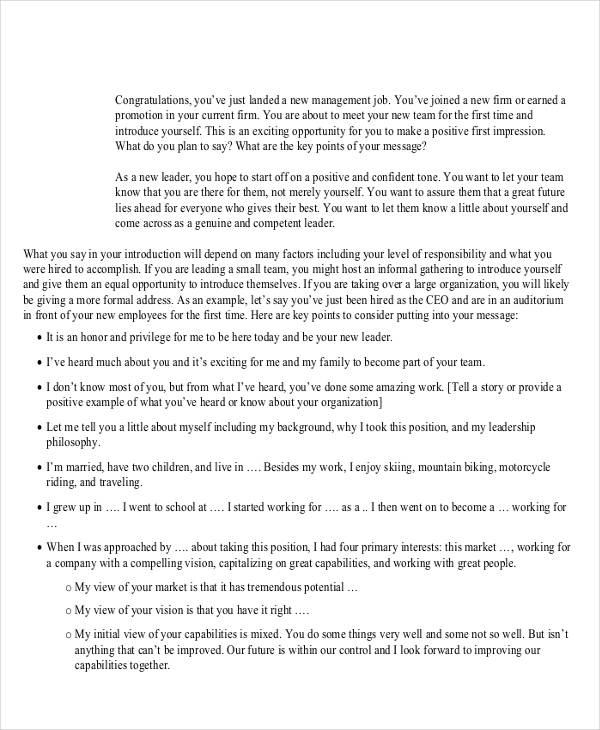
Size: 47 KB
3. Introduction Speech for Chairman
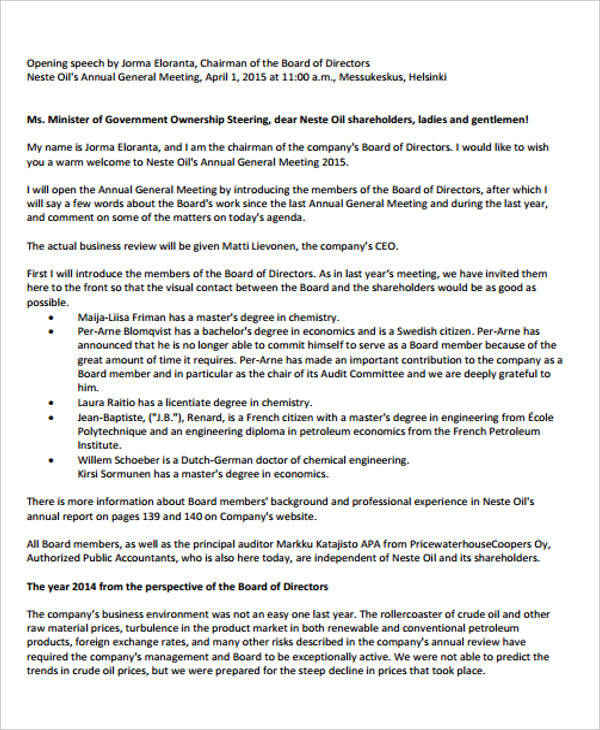
Size: 281 KB
4. Introduction Speech for Students
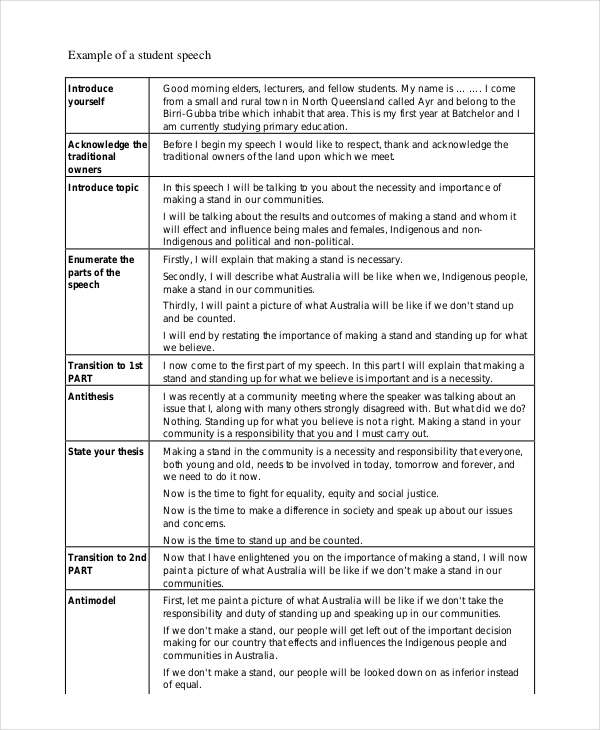
waalc.org.au
Size: 13 KB
5. Formal Introduction Sample
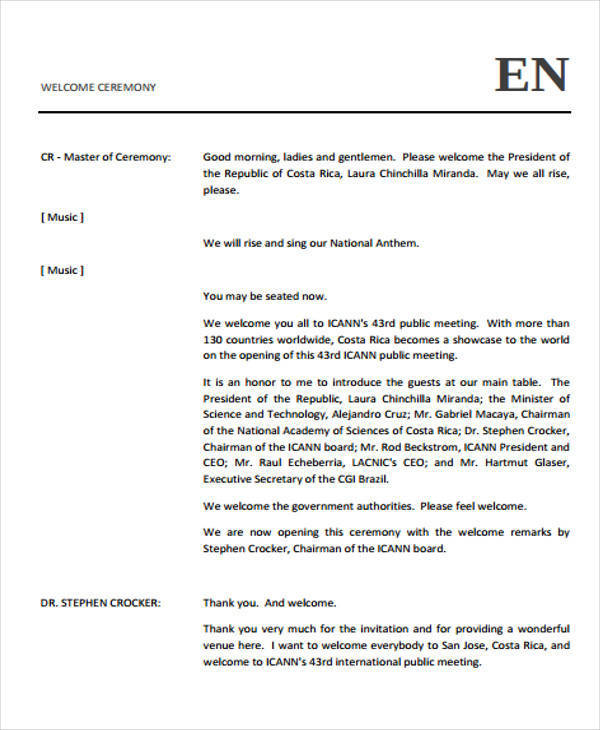
Size: 223 KB
6. 30 Second Self Introduction Speech for School Students
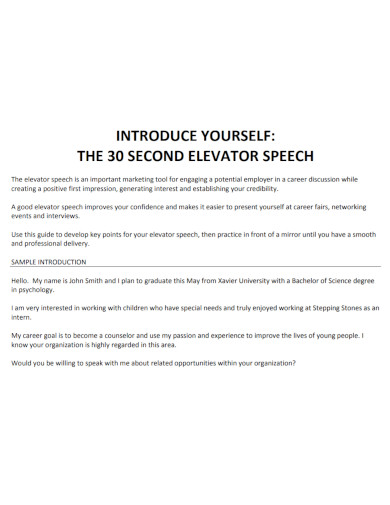
7. Self Introduction Speech for School Students
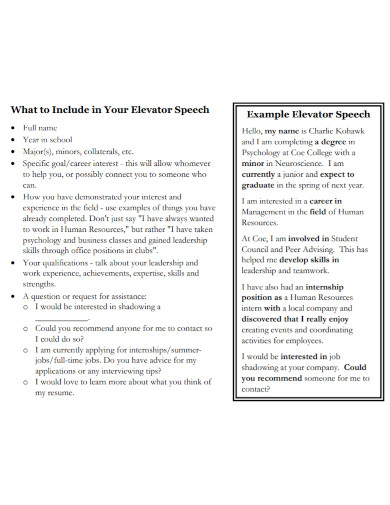
Size: 342 KB
8. New Self Introduction Speech for School Students

Size: 144 KB
9. Self Introduction Speech for School Students Template
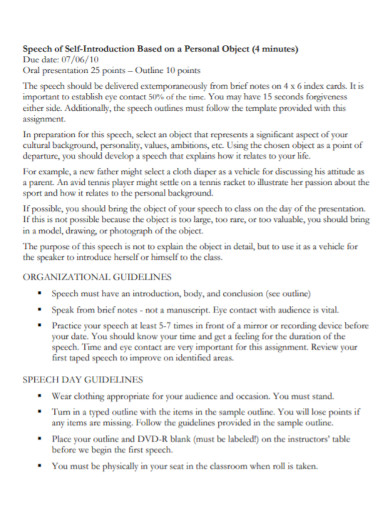
Size: 83 KB
10. 5 Minute Self Introduction Speech Template
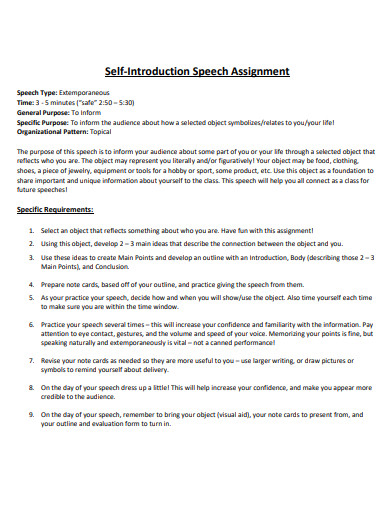
Size: 448 KB
11. Sample 5 Minute Self Introduction Speech
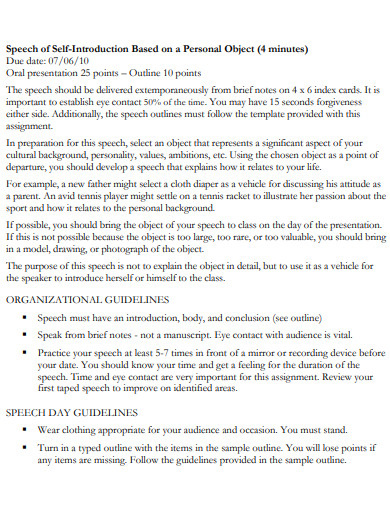
12. Basic 5 Minute Leader Speech
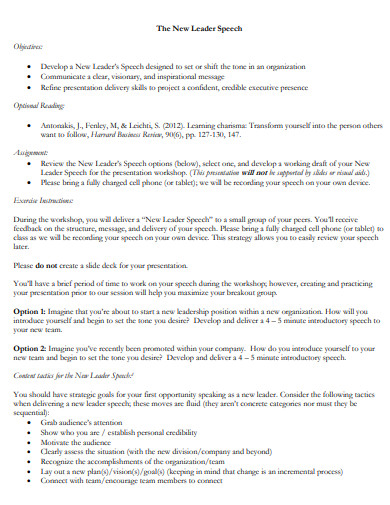
Size: 141 KB
13. Public Communication Speech
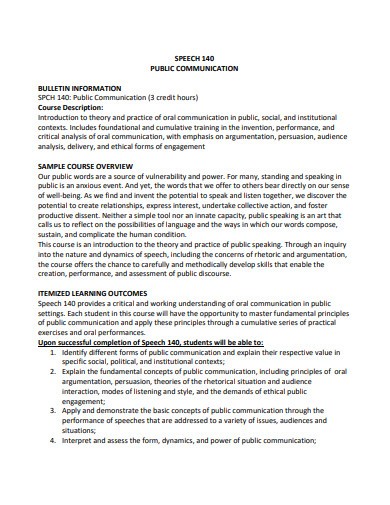
Size: 103 KB
14. 2 Minute Self Introduction Speech Template
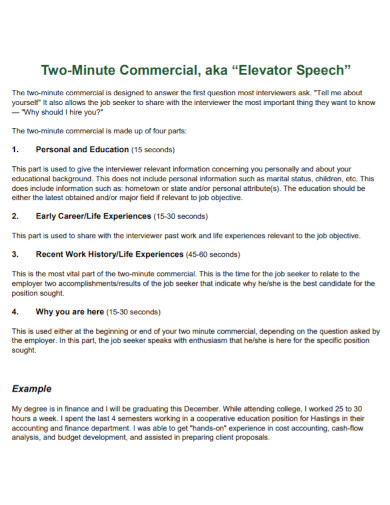
Size: 143 KB
15. 2 Minute Self Introduction Speech for Students
16. 2 minute self introduction speech for school students, 17. 2 minute self-introduction speech evaluation form.

Size: 201 KB
18. 30 Second Introduction Speech about Yourself
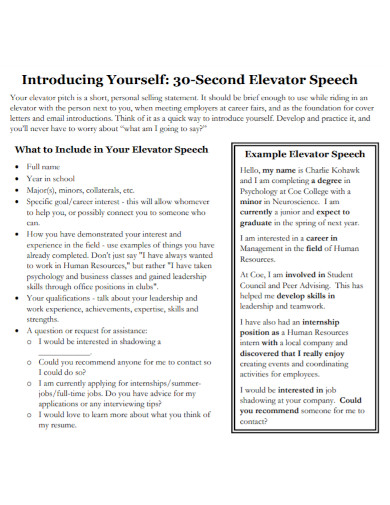
19. Introduction Speech about Yourself Example
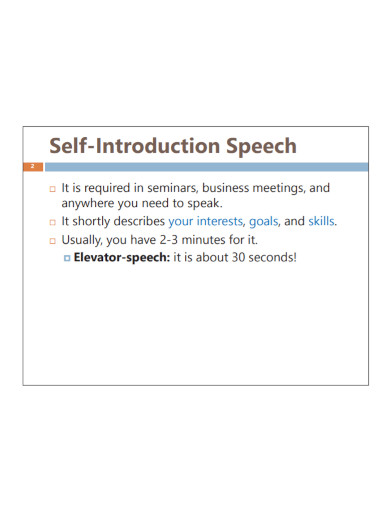
Size: 115 KB
20. Self Introduction Speech about Yourself
21. self-introduction speech based on a personal object, 22. printable introduction speech about yourself, 23. sample new manager introduction speech.
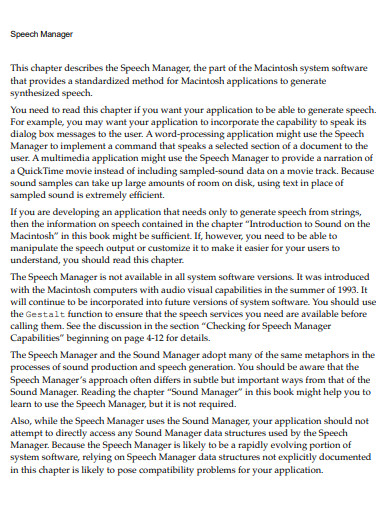
Size: 357 KB
24. Basic New Manager Introduction Speech
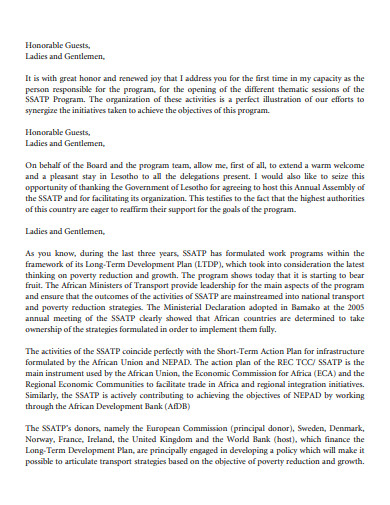
Size: 31 KB
25. New Manager Introduction Speech Example
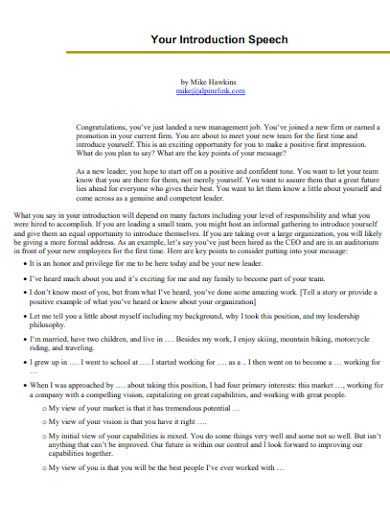
26. New Manager Introduction Speech in PDF
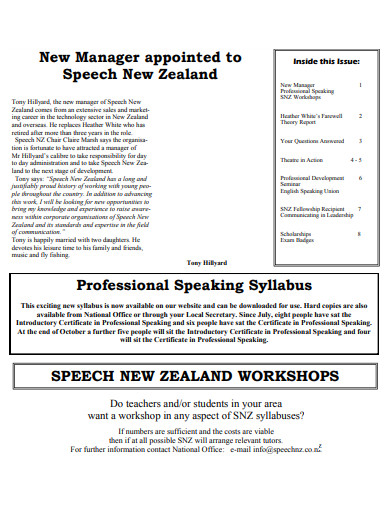
Size: 663 KB
What is a Speech Introduction?
A speech introduction is the opening segment of a speech or presentation that aims to draw the audience’s attention and create an immediate connection with the topic. It serves as the gateway to your main ideas, allowing you to present your message effectively. A well-crafted speech introduction can establish the context, highlight the importance of the subject matter, and engage the audience’s curiosity.
How to Write a Speech Introduction
Welcome to the step-by-step guide on crafting a captivating speech introduction! Whether you’re preparing for a formal presentation, a persuasive talk, or simply want to engage your audience effectively, this guide will walk you through the essential elements and techniques to create an attention-grabbing opening. Let’s dive in and learn how to captivate your listeners from the very beginning!
Step 1: Understand Your Audience
Before diving into crafting your speech introduction, take the time to observe your audience. Consider their interests, knowledge level, and preferences. Tailor your introduction to resonate with them, making it relatable and engaging. Understanding your audience will allow you to choose the right tone, language, and examples that best suit their needs.
Step 2: Develop a Clear Purpose
Define the purpose of your speech introduction. Are you trying to inspire, inform, or persuade? Knowing your objective will help you create a focused and impactful opening. Your purpose will also guide the structure and content of your introduction, ensuring that every word contributes to your overall message.
Step 3: Craft an Attention-Grabbing Opening
Begin your speech with a hook that captures the audience’s attention immediately. You can use a surprising statistic, an intriguing question, a relevant quote, or a compelling story. The key is to pique their curiosity and make them eager to hear more. The opening should be concise and powerful, setting the stage for the rest of your presentation.
Step 4: Provide a Roadmap
After the attention-grabbing opening, present a clear and concise outline of your speech. This roadmap gives the audience an overview of what to expect, guiding them through the main points you’ll be addressing. Outline formats can vary, but make sure it’s easy for the audience to follow and understand the structure of your speech.
1. Why is a strong speech introduction essential?
A compelling speech introduction captivates the audience, making them more likely to pay attention throughout the presentation. It sets the context, establishes your credibility, and sparks interest in your message.
2. Should I use literary devices in my speech introduction?
Using literary devices like metaphors, similes, or anecdotes can add flair and memorability to your introduction. However, use them judiciously, considering the context and your audience’s preferences.
3. Can I use both simple and compound sentences in my introduction?
Yes, varying your sentence structure adds rhythm and flow to your speech. Combine simple sentences for clarity with compound sentences for complexity and impact.
In conclusion, crafting an effective speech introduction requires careful consideration of your audience, purpose, and content. By following the step-by-step guide and incorporating attention-grabbing elements, you can deliver a compelling opening that leaves a lasting impression. Remember to use appropriate verbs and common nouns to keep your introduction clear and concise. By mastering this art, you set the stage for a powerful presentation that will undoubtedly resonate with your listeners.
Text prompt
- Instructive
- Professional
Write a Speech Introduction for a keynote speaker at a conference.
Create a Speech Introduction for a guest lecturer in a university class.
My Speech Class
Public Speaking Tips & Speech Topics
Self Introduction Speech [Topics + Outline Sample]

Jim Peterson has over 20 years experience on speech writing. He wrote over 300 free speech topic ideas and how-to guides for any kind of public speaking and speech writing assignments at My Speech Class.

This page deals with self introduction speech topics for classroom or other public speaking events an opportunities in life for a good first impression.
In this article:
Sample Introduction Speech Topics
Sample self introduction speech outline.
Another short manner for introducing yourself is the elevator speech, meant for business purposes.
The key question for successful and effective presenting yourself to others in both occasions is: how much and what information do you want the audience to know about you?
Due to the fact you have to write your talk around one theme, I recommend to develop one aspect of your life. That aspect will tell who you are and what you are about. Some people call this type a one-point preliminary, because it is based on one speaking idea.
Can We Write Your Speech?
Get your audience blown away with help from a professional speechwriter. Free proofreading and copy-editing included.
Look at the sample self introduction speech topics and pick out the aspects of your personal life you want to share with the audience. Approach the list below with the who, the what, the whereabouts, for sure the why, the how and when questions. That is an effective way to outline your first thoughts.
- What activity has played or plays an important part in your life? Tell the story and distract the message.
- What is your main personal goal?
- What do you like very much? Your hobby?
- What do you hate or dislike? Your aversions?
- Do you have developed a very special skill?
- What is your lifestyle?
- Can you come up with a turning point or milestone in you life?
- What is your hobby or interest in your spare time?
- What is a pet peeve or another very familiar topic you like to talk about, to do or to discuss?
- Where you are from? Do your roots reveal something about yourself that is new for the audience? That always works in a small nice text for introducing your biggest personal features.
- Is there an object or prop that means a lot to you?
- What distinguishes you from other individuals in class?
Now that you have picked out a central thesis, use this example profiler I have created:
Grab their attention . Immediately bring in your central message and come to the point.
Give some background information . Tell why it is important to you, why you are doing it, why you want to tell them, etcetera.
Now work out your item of discussion in a few sentences. Draw the contours, make it personal.
Give an example .
In conclusion, offer a memorable answer in your self-introduction speech on the question the listeners probably will have when they listen to your public speaking efforts: what’s in it for me? Tell how this aspect of your life makes who you are and what you are. It will be the perfect ending of your spoken presentation.
113 Extemporaneous Speech Topics
147 Unique Speech Topics [Persuasive, Informative]
2 thoughts on “Self Introduction Speech [Topics + Outline Sample]”
i think that talking about some people that have influenced you the most really gives good base to your speech and it helps you by writing about things that you are familiar with so if you write about what has inspired you and what you care about you can easily write about anything.
Domestic violence
Leave a Comment
I accept the Privacy Policy
Reach out to us for sponsorship opportunities
Vivamus integer non suscipit taciti mus etiam at primis tempor sagittis euismod libero facilisi.
© 2024 My Speech Class

Make A Speech Introduction That Grabs Audience Attention

The speech introduction is the first part of a speech and the first opportunity to grab the audience’s attention. The speaker should state the topic, make it relatable to the audience, establish credibility and preview the main points. You should write or finalize your introduction at the end so that it reflects what you actually said.
Listen up, audience!
No matter whether you are giving an informative speech to enlighten an audience about a certain topic or a persuasive speech aims to convince the crowd to adopt a particular viewpoint. But whichever type of speech you’re writing or delivering, one thing is true: You must create an attention-grabbing speech introduction.
Table of Contents
What Is The Best Way To Start A Speech?
Whether in speech writing or public speaking, the role of a good intro cannot be understated. It is your best chance to captivate your audience’s attention and entice them to be with you until the rest of your speech.
It’s also your opportunity to introduce the topic and thesis statement and set up the points you’ll discuss later. So, keep in mind that you emphasize the relevance of your subject matter to the audience and contextualize it properly.
These are some of the best ways to make a compelling introduction speech.
- State a quote or use a historical event reference. Analyze your target audience and look for a powerful quote from a relevant figure or a historical event that will resonate with listeners and relate it to your topic. A notable quotation can immediately establish a strong connection. On the other hand, an important event will help you illustrate your point or paint a scenario better.
- Share a personal story. Sometimes, you don’t have to search far and wide to demonstrate a point. You can tap into your personal experience and share something about yourself. Generally, audience members enjoy hearing stories as they pique their interest and get a glimpse of who the speaker is. Your anecdotes will also make you more human and accessible.
- Start with an “Imagine” or “What if?” scenario. Want to make your audience engaged? Let their imagination run. In many speeches over the years, some of the most successful ones used this technique. Speakers transport the audience to the future or a scenario wherein their proposed idea or belief reigns. For example, “What if we live in a world where everyone can access healthcare?”
- Count on a video or any other visual aids. If you’re a public speaker keen to use technology, you may also want to commence your speech with visual aids. For instance, you can show a pre-prepared video to draw the crowd’s attention right before you speak. If you’re talking about hunger and food security, you can show footage of how such issues take a toll in many third-world countries.
- Tell surprising statistics. One of the most effective ways to shock — and, ultimately, grab your audience’s attention is by telling real, hard facts. If you’re looking for a good attention-getter, you can rely on surprising statistics about your topic. For instance, if your topic is bullying, you can mention that in the US, around 3 million students are victims of bullying.
- Ask the audience a question. Another way to hook your audience is by asking them a question. It can be a direct one (e.g., “Who among here are…” then ask for a show of hands). It can also be a rhetorical question (e.g., “What is the meaning of life?”). The key is interacting with the crowd to get their attention and effectively introducing your subject matter.

What Should You Include In the Introduction?
When you look at intro samples and templates on the web, you’ll find that effective speech introductions contain key elements. And one of the most important is your attention-grabber, which will compel your audience to listen to your speech and narrative.
You must also introduce your speech topic and indicate why it matters to your audience. You should also share something about yourself, especially your credibility, to discuss a particular subject matter.
Once you’ve laid out these foundations, state your central idea or thesis statement. Tell the audience members the point of view you want them to adopt, and give them a preview of the main points you’re discussing if you’re giving a persuasive speech. If you’re writing or delivering an informative one, you can provide them with a brief speech outline or the key points you’ll touch upon throughout the body of the speech.
What Are The Best Lines To Introduce A Speech?
One of the most common public speaking tips you’ll encounter is to have a good introduction. To help you capture the audience’s attention, here are some ideas you can use in your speech.
- A famous quote (For example, “Innovation distinguishes between a leader and a follower” by Steve Jobs)
- A song lyric (“Imagine there’s no countries/ It isn’t hard to do/ Nothing to kill or die for/ And no religion, too,” from “Imagine by John Lennon)
- A line from a poem (“You may write me down in history With your bitter, twisted lies, You may trod me in the very dirt But still, like dust, I’ll rise,” from “Still I Rise” by Maya Angelou)
- A line from a movie (“Greed, for a lack of a better word, is good,” from “Wall Street”)
- Reference to a historical event (“Two hundred years ago, one of the most important proclamations was made. Through the Emancipation Proclamation issued by President Abraham Lincoln, the enslaved Black people were given freedom.”
- Reference to a notable figure (“Stan Lee, the man behind iconic Marvel characters, was hired as an editorial assistant at a comics company after graduating high school.”).
- A bold statement (“Prostitution must be legalized.”)
- A serious statement (“Climate change is a pressing issue.”)
- A humorous line (“Don’t underestimate me. That’s the job of my mom.”)
- A shocking statistic (“If you’re consuming too much fast food and baked goods, did you know that you are 51% more likely to be depressed?”)
- A direct question (“Who among here plays violent video games?”)
- A rhetorical question (“Is there a more powerful feeling than love?”)
- A personal story (“Back when I was a fresh college graduate, I busied myself applying to the top multi-national companies.”)
- An anecdote (“Long ago, there was a man — an old but healthy man — who dared climb Mount Everest. He was 80, and he succeeded.”)
- A what-if scenario (“What if there were no poor people?”)
How Do You Introduce Yourself In A Speech?
Whether you’re a first-time speaker or a veteran, how you approach introducing yourself in a speech is important in establishing your credibility. To avoid getting called boring, you might want to shy away from the usual “Hi, everyone. I’m (your name). I (your credentials), and today I will be talking about (points of the speech).”
Usually, someone else may have given your name and background. This gives you the liberty to begin your speech more interestingly.
You can start by stating any of the introduction lines listed above, then transition to why listening to you will matter to them. For example, if you’re talking about mental health and depression, you can follow up a surprising statistic with something like, “I know because I was a part of that statistic. Now, I’ve studied to become a therapist myself.”
To further create an air of authority, you must be mindful of your body language (taking a deep breath before speaking can help you shake off your nervousness and tension). Additionally, you must make eye contact and speak words clearly.
How Do You Introduce A Speaker?
Now, if you’re tasked to introduce the one who will deliver the speech, it’s your responsibility to set the right atmosphere and build excitement.
One of the first things to do is know how to pronounce the speaker’s name and ensure that what you’ll say about the speaker’s credibility is factual. Since you’re only introducing the speaker, keep things simple and concise. If you want to enrich your introduction, you can ask the speaker what they want to be highlighted (Do they have a new book? Which prestigious groups are they affiliated with?).
Like what the speaker would do, you must also make eye contact to engage the audience. Practice and have a run-through before you take the stage to guarantee a smooth delivery.

What Is An Example Of A Speech Introduction?
Speakers and speech writers know how challenging it is to grab an audience’s attention. Here’s a good example of an introductory speech that uses statistics. This is from English restaurateur Jamie Oliver who delivered a TED Talk about food:
“Sadly, in the next 18 minutes when I do our chat, four Americans that are alive will be dead from the food that they eat.
My name’s Jamie Oliver. I’m 34 years old. I’m from Essex in England, and for the last seven years, I’ve worked fairly tirelessly to save lives in my own way. I’m not a doctor; I’m a chef, I don’t have expensive equipment or medicine. I use information, education.”
What Is The Introduction For A Speech On Bully
Looking for inspiration for a good introduction where your topic is bullying? Check out this sample intro from actress and UNICEF Goodwill Ambassador Millie Bobby Brown during World Children’s Day in 2019:
“In world capitals — in buildings like this — adults talk about children’s rights. But today, young people don’t want to be talked about. They want to do the talking.
Millions of people responded to UNICEF surveys and petitions about what the Convention on the Rights of the Child meant to them. In the words of one young person: ‘Be an active voice. Don’t let things go unnoticed. So today, I want to talk about an issue that is very personal to me. Something that so often goes unnoticed — but causes real suffering. Bullying.”
What Are Some Other Examples Of Speech Introductions?
Below are some more speech introduction examples you can take inspiration from.
- “Three things I learned while my plane crashed” by Ric Elias : “Imagine a big explosion as you climb through 3,000 ft. Imagine a plane full of smoke. Imagine an engine going clack, clack, clack, clack, clack, clack, clack. It sounds scary. Well, I had a unique seat that day. I was sitting in 1D.”
- “How to find and do work you love” by Scott Dinsmore : “8 years ago, I got the worst career advice of my life.”
“How great leaders inspire action” by Simon Sinek : “How do you explain when things don’t go as we assume? Or better, how do you explain when others are able to achieve things that seem to defy all of the assumptions?”
Recent Posts
Active Listening Absorbs The Whole Message, Not Just The Words
Active listening goes beyond hearing the words someone is saying to you and understanding the message they are conveying. Many only hear a small percentage of what is being said as they are...
Counteracting Fear Of Public Speaking With Coaching And Therapy
Nearly 75% of people experience the social phobia of fear of public speaking. The result may be nervousness before speaking or a full-blown panic attack. Practicing public speaking may lessen the...

Want to create or adapt books like this? Learn more about how Pressbooks supports open publishing practices.
31 Examples of Introductions
Below you will find examples of informative and persuasive introductions. Notice that each contains the five elements necessary for a good introduction: an attention getter, the establishment of rapport with the audience, the speaker’s credibility, a clear topic reveal, and clearly articulated main points. An important point to mention about the introduction is that the parts should flow or “bridge” into each other. You do not want to have a disconnect between the attention getter, the credibility enhancer, the rap- port, and the reveal. You also can switch the rapport and credibility sections if it makes more sense, but definitely start with the attention-getter and end with the preview.
(Note: We have written these introductions out as paragraphs, but your instructor may require you to present them in a different format in your outline.)
Informative Speech Introductions
Topic: allergies.
My parents knew that something was really wrong when my mom received a call from my home economics teacher saying that she needed to get to the school immediately and pick me up. This was all because of an allergy, something that everyone in this room is either vaguely or extremely familiar with. Allergies affect a large number of people, and three very common allergies include pet and animal allergies, seasonal allergies, and food allergies. All three of these allergies take control over certain areas of my life, as all three types affect me, starting when I was just a kid and continuing today [attention-getter]. Because of this, I have done extensive research on the subject, [credibility] and would like to share some of what I’ve learned with all of you today. Whether you just finished your freshman year of college, you are a new parent, or you have kids that are grown and out of the house, allergies will most likely affect everyone in this room at some point [rapport]. So it will benefit you all to know more about them, specifically the three most common sources of allergies and the most recent approaches to treating them [purpose and preview].
Topic: Seasonal Affective Disorder (See if you can identify the parts on Example 2.)
When winter is approaching and the days are getting darker and shorter, do you feel a dramatic reduction in energy or do you sleep longer than usual during the fall or winter months? If you answered “yes” to either of these questions, you may be one of the millions of people who suffer from Seasonal Affective Disorder, or SAD. For most people these problems do not cause great suffering in their life, but for an estimated six percent of the United States population these problems can result in major suffering. As a student in the registered nursing program here at State College, I became interested in SAD after learning more about it and want to share this information with all of you in case you recognize some of these symptoms in yourself or someone you love. In order to fully understand SAD, it is important to look at the medical definition of SAD, the symptoms of this disorder, and the measures that are commonly used to ease symptoms.
Persuasive Speech Introduction
Topic: term life insurance.
You have cried silent tears and uttered desperate prayers, but as you watch the medical team unhook the tubes, turn off the heart monitor and shoot furtive, helpless glances your way, you face the unmistakable reality that cancer has won over your loved one and you are left with unimaginable grief, despair and yes, financial burden. Most of us would not choose to cause our loved ones financial pain on top of the emotional pain of our deaths, but by failing to plan for their financial needs, that is exactly what we do. I have learned a lot about life insurance in my research for this presentation, from taking a thirteen-week course about financial matters, and from the experience of purchasing a term life insurance policy just last year. I know most of you probably have not thought much about life insurance, but someday each and every one of us in this room will pass away and somebody is going to have to pay for our funerals. Term life insurance is affordable, protects those you love from the financial devastation of your uninsured death, and reinforces your commitment to their financial and emotional well-being while you are living. Let’s examine the definition of term life insurance and then its benefits.
Exploring Public Speaking Copyright © by Edited by Nicolet College is licensed under a Creative Commons Attribution-NonCommercial-ShareAlike 4.0 International License , except where otherwise noted.
Share This Book

IMAGES
VIDEO
COMMENTS
Discover the art of crafting compelling introduction speeches through our comprehensive guide. Whether you’re a beginner or a seasoned speaker, our step-by-step approach simplifies the process. Explore a rich collection of speech examples, tailored to inspire and improve your public speaking skills. Master the nuances of delivering impactful ...
An introduction speech, or introductory address, is a brief presentation at the beginning of an event or public speaking engagement. Its primary purpose is to establish a connection with the audience and to introduce yourself or the main speaker.
Write your speech introduction using one of these 12 captivating attention getters and easily hook your audience's attention.
Sample 1. Ladies and gentlemen, distinguished guests, and members of the audience, I extend my warmest greetings to all of you. It is both a pleasure and a privilege to stand here before you today, tasked with the delightful challenge of introducing myself.
How to write a good introduction speech step by step. By: Susan Dugdale. If you've been asked to give the introduction speech for a guest speaker you're in the right place. Everything you need to prepare it is here. Follow the steps and you'll have an introductory speech you'll be proud to deliver.
Master the art of captivating your audience from the start with compelling speech introduction examples. Learn how to create attention-grabbing openings, develop a clear purpose, and provide a roadmap for your speech.
Self introduction speech tutorial including twelve speech topics for effective presenting and a sample outline to introduce your personal features briefly to all intents and purposes.
A speech introduction grabs the audience’s attention so that they are ready to receive the main message. Here are some introduction speech examples to help you.
When you look at intro samples and templates on the web, you’ll find that effective speech introductions contain key elements. And one of the most important is your attention-grabber, which will compel your audience to listen to your speech and narrative.
Below you will find examples of informative and persuasive introductions. Notice that each contains the five elements necessary for a good introduction: an attention getter, the establishment of rapport with the audience, the speaker’s credibility, a clear topic reveal, and clearly articulated main points. An important point to mention about ...